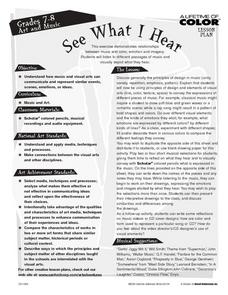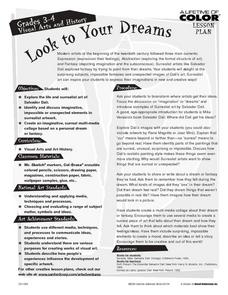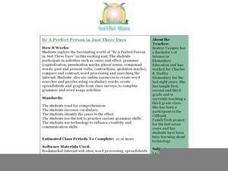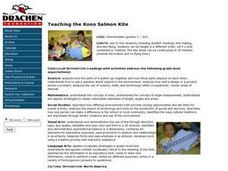Curated OER
We Can Work It Out
Students practice conflict resolution by considering alternatives before reacting to a conflict.
Curated OER
Rights in Conflict
Learners study situations where rights are in conflict. In this conflict in rights lesson, students review a conflict situation and the Supreme Court ruling for the issue. Learners review the Bill of Rights and then receive their own...
Curated OER
The Art of the Quilt
Students examine why fabric was first sewn in layers and how it was used. They identify, compare and make 3 different fabric design types which will become a basis for looking at the quilts created by African Americans. They begin the...
Curated OER
Looking at Portraits - Portraits in Line
Students use Van Gogh’s Portrait of Joseph Roulinas inspiration for their own portraits of friends in the classroom. In this portrait lesson, students analyze the Van Gogh portrait and discuss his techniques. Students discuss facial...
Curated OER
Theme vs. Topic
Students use Aesop's fables to examine theme and topic. In this theme and topic lesson, students read different fables and discussing as a class. After hearing more stories students work in pairs to determine the theme or topic.
Curated OER
O Time, thou must untangle this": Tangling up the Love in Twelfth Night
Tenth graders are broken into groups to review a section of The Twelfth Night. They are then given a handout of the same material in which they are to break up material which conveys a single idea. They are to preform this idea to the...
Curated OER
Skimming
Students examine how to skim textual material. They read an article, and identify the main ideas by reading first and last paragraphs, topic sentences, and other organizational clues.
Curated OER
Problem and Solution Lesson
Students explore problems and solutions in literature. In this literature lesson, students identify problems and solutions in short guided and independent reading samples. Students also discuss characterization techniques used to develop...
Curated OER
Immigrants & Community
Students examine how different groups of immigrants contributed to the growth of specific communities. After reading a novel, they keep a journal on the important elements found and create a map of the community portrayed. Using the...
Curated OER
See What I Hear
Students investigate the link between music and visual art by applying principles of design to convey the emotions/expressions in different types of music.
Curated OER
Playing with Language: Tall Tales and Codes
Pupils interpret and identify the elements of folktales, with an emphasis on tall tales, in this lesson. Students utilize brainstorming techniques to list ways people communicate. Pupils also read and create a time line and present...
Curated OER
Look to Your Dreams
Students research the life of surrealist artist Salvador Dali and create their own "surreal" art in the form of a collage, based upon their dreams or fantasies.
Curated OER
Language Arts: A "Perfect" Lesson
Students read "Be A Perfect Person in Just three days," and participate in a host of activities. Connected to technology, they use online sources to create word searches and puzzles from vocabulary words. In addition, students create...
Curated OER
Lots of Lines
Students see that artists make many different kinds of lines. They discuss how artists use line to show ideas such as motion, mood, or emphasis. They geet a "scribble" to transform into a picture using Colorific markers or erasable crayons.
Curated OER
Reading the Play
Middle schoolers read the play "Julius Caesar" by William Shakespeare. In groups, they identify the instances of similes, metaphors and personification. They use the Internet to compare and contrast the events in the play with historical...
Curated OER
Once Upon a Genre
Students examine fractured fairy tales before responding by writing in many different genres including a persuasive essay, a personal narrative, a letter, an advertisement, and a resume'. They create a pop-up book with their written...
Curated OER
Because of Winn-Dixie
Students complete a variety of activities related to the book "Because of Winn-Dixie" by Kate DiCamillo. They create a scrapbook of the characters in the book, play a reading comprehension maze game, and participate in an online...
Curated OER
Heaven or Ground Hog Day?
Learners discover the ideas of enlightenment by reading historical poetry. In this philosophical lesson, students read poems by Sir Walter Scott and Sergeant Joyce Kilmer while discussing the themes of the writing with classmates....
Curated OER
Much Ado About Something (Lesson 2)
Students view more video clips of Shakespeare's plays. They answer comprehension questions over the video. They are introduced to the language Shakespeare used as well.
Curated OER
A Picture Says a Thousand Words
Students create a writing selection with a well-developed plot. They use a personal photograph in which they are visible to base their autobiographical writing. They write a description of the events surrounding the photograph in the...
National Endowment for the Humanities
Chinua Achebe's Things Fall Apart: Oral and Literary Strategies
Readers are first introduced to Chinua Achebe's Things Fall Apart by making a map of Africa. They will better understand the novel's historical and literary contexts, European and African literary traditions, and how historical events...
Curated OER
Teaching the Bell Tetrahedral Kite
Students complete readings on kite making and kite flying. They analyze how the parts of a system interconnect and influence each other. Students identifies and uses color and form in a 3D artwork.
Curated OER
Teaching the Kono Salmon Kite
Students complete several student readings involving kite making and kite flying. They analyze how the parts of a system go together and how these parts depend on each other. They comprehend how different environments both provide...
Curated OER
Religion Through Language Arts & History
Students explore the principal religions which are alive today: Islam, Judaism, Hinduism, Buddhism, Christianity, and the Philosophies of the Chinese. They determine that there are scientific explanations for many of the subjects that...

























